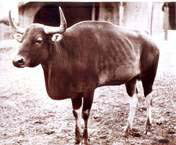Kouprey
From Wikipedia, the free encyclopedia
Kouprey (Bos sauveli also known as Kouproh) is a wild forest-dwelling ox found mainly in northern Cambodia but also believed to exist in southern Laos, western Vietnam, and eastern Thailand. It was discovered in 1937.
Kouprey is a very large ungulate, about the same size as wild Water Buffaloes. Male Kouprey stand up to two metres tall at the shoulder and weigh an average of 900 kilograms. However, the kouprey herds recently discovered in Vietnam have individuals attaining weights of about 1700 kg or so, according to Vietnamese zoologists. Kouprey have large but narrow bodies, long legs and humped backs. Kouprey can be either grey, dark brown or black. The horns of the females are lyre-shaped with antelope-like upward spirals the horns of the male are widespread and arch forward and upward, which begin to split at about three years of age. Both sexes have notched nostrils and long tails. Kouprey have two toes at the centre of their hooves, the index and small toes are small hoof like parts close to the ankle.
Kouprey live in low partially forested hills where they eat mainly grasses. Kouprey are diurnal, eating in the open at night and under the forest cover during the day. They live in herds of up to twenty, generally consisting of only cows and calves but also bulls during the dry season.
There are estimated to be less than 250 kouprey left in the world. These low numbers are attributed to uncontrolled hunting by locals and soldiers in conjunction with diseases introduced from cattle and loss of habitat. However the kouprey is suspected to have always been somewhat rare.
Relation to other species
Recent research published by Northwestern University in London's Journal of Zoology indicates that a comparison of mitochondrial sequences shows the Kouprey is a hybrid between a Zebu and a Banteng. However, French scientists Alexander Hassanin and Anne Ropiquet of the National Museum of Natural History in Paris argue that the Kouprey is a separate species. Both camps agree that more extensive testing wil be required to determine who is correct.
http://en.wikipedia.org/wiki/Kouprey
| The text in this page is based on the copyrighted Wikipedia article shown in above URL. It is used under the GNU Free Documentation License. You may redistribute it, verbatim or modified, providing that you comply with the terms of the GFDL. |
|

